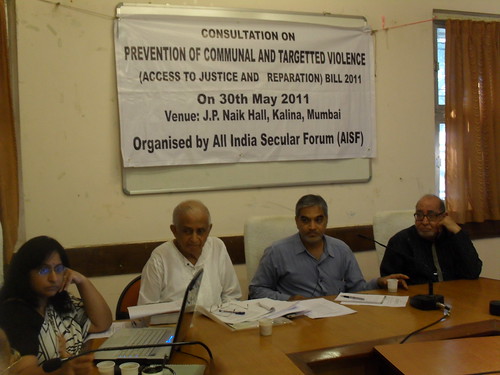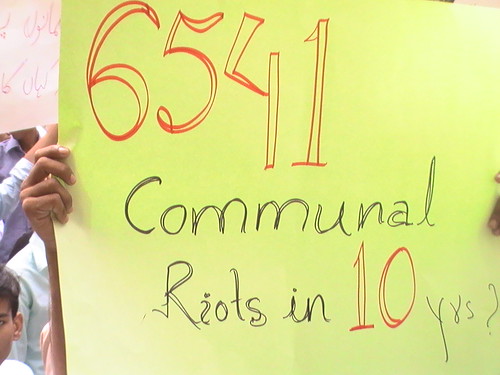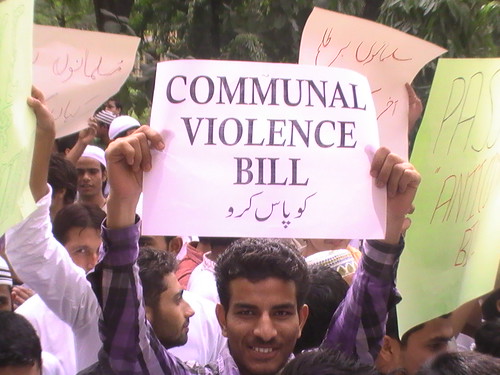By M Reyaz,
As the United Progressive Alliance (UPA) Government decided to not table the Anti-Communal Violence Bill amidst much din in the Upper House of the Parliament on February 5, 2013, it becomes clear that none of the parties are really serious on the question of security of the minority communities, particularly when it comes to the issues of accountability, justice, rehabilitation.
The politics of riots and politics over riots are not new to this country and none of the political parties can absolve of their collusion into it, some are guilty of inciting riots, while others of allowing it to happen by shirking of their responsibilities, mainly for larger political calculations. Still others – most Muslim leaders and groups included – are equally the culprits for looking on the other side, only to later beat the drum of victimhood, at best; or worse, to reap political benefits, at times.

Riot as ‘policy’: One reason why ethnic and communal riots have virtually become a sort of ‘policy’ for many groups and parties, is that experiences show that the culpability of these often well-orchestrated and planned heinous crimes go escort free. Take the example of recent Muzaffarnagar riots, most of the perpetrators of crimes as grave as murder and rapes are living in their own villages and homes (if media reports are to be believed) even five months after the riots, while the same UP police recover the seven buffaloes of a powerful minister in two days.
In a well-argued Op-Ed ‘Reading the clean chit’ in Indian Express Vinay Sitapati, a lawyer and Research Scholar at Princeton, argued, “In their sloppily argued, partisan bid to pin a larger tragedy on one man, the Congress party and some NGOs have unwittingly made the Gujarat riots seem less horrific than they actually were.” I am in agreement with the writer that in trying to prove the Gujarat’s Chief Minister’s culpability, the civil society seem to have ignored the culpability of hundreds of murders and rioters who needed to be prosecuted.
Of course criminals and murderers must be punished but the buck must also stop somewhere, the culpability of those on top for abatement too must be fixed. When puppies die and the owner of the car, who presents an image of someone who believes in driving his own car and keeping the keys with himself, must explain to the dogs and bitches and to all animal loving human, why on that fateful night, he continued sitting at the back – and worse escaped the spot and maintained silence all along? Then prime minister must explain, why he kept himself busy in praying or sleeping the whole day as the Babri Mosque was being demolished? If he knew that when a big tree falls, the earth shakes, instead of justifying the reactions, why did administration not act in time?
Former Additional Director General of Police of Uttar Pradesh Vibhuti Narain Rai, who was SSP of Meerut during the infamous Hashimpura riot said, “If any riot is not quelled within 24 hours, then either the government is inapt or complicit” for some political agenda.
Fate of Riot Cases: In response to an RTI query by news-portal BeyondHeadlines, the Home Ministry replied that 26817 communal riots took place between 1984 and 2012, in which 12902 lost their lives. According to the government figure, there were a total of 668 communal incidents in 2012, in which 94 people were killed and 2117 injured. In 2013 for data till October, number of incidents has jumped to 725 and number of people killed showed an increase of 50% with 143 killed and 1978 injured. Of course these are very conservative figures and actual number may be much more, but what needs to be pointed out that very few perpetrators of riots have been brought to justice.

L-R- Saumya uma, Justice H.Suresh, Irfan Engineer, (late)Asghar Ali Engineer (File Photo)
Meanwhile, the riot/pogrom victims long wait for justice never seems to end. 1948 rape and massacre of Muslims in Hyderabad that ensued after Operation Polo is not even a point of discussion. The little spoken Sunderlal report estimates that an estimate 200,000 Muslims were massacred. Similar has been the fate of most riots whether 1983 Nellie massacre, 1984 anti-Sikh riots, 1987 Hashimpura riot, 1989 Bhagalpur, 1992 Mumbai, 2002 Gujarat, 2008 anti-Christian riots in Odisha, and so on and so forth.
The report of an investigative commission formed under Justice B.N. Srikrishna to enquire into the communal frenzy of December 1992 and January 1993, in which around 900 people died, is biting the dust of the Maharashtra Secretariat, with shamelessly no action. No one even talks about the Ghulam Hussain report on Maliana riots and Gian Prakash Committee Report on Hashimpura massacres in Meerut.
Need for compressive law: The need for comprehensive laws to deal with cases of communal riot was long felt as the local state administration is often seen colluding and abating in riots – never more visible than the 2002 Gujarat riots. Sensing the mood, Congress party had promised to legislate laws to this effect in its 2004 manifesto of the general elections, in which it defeated the BJP lead National Democratic Alliance (NDA). “The Congress will adopt all possible measures to promote and maintain communal peace and harmony, especially in sensitive areas. It will enact a comprehensive law on social violence in all its forms and manifestations, providing for investigations by a central agency, prosecution by Special Courts and payment of uniform compensation for loss of life, honour and property,” read the 2004 Manifesto.

As the UPA came to power, with the outside support of the Left Parties, the proposal was included in the Common Minimum Programme as well, under the head of ‘Social Harmony, Welfare of Minorities’: “The UPA government will enact a model comprehensive law to deal with communal violence and encourage each state to adopt that law to generate faith and confidence in minority communities.”
Based on the suggestions of several civil society groups consisting of non-governmental organizations, judges, police officers, writers and social activists, UPA Chairperson Sonia Gandhi led National Advisory Council (NAC) drafted an Anti-Communal Violence Bill by 2004 end itself. By the middle of 2005, largely based on the NAC’s suggestions, Home Ministry drafted and circulated a Communal Violence (Suppression) Bill 2005.
Since 2005, the UPA government is practically playing hide and seek when it comes to the Communal Violence (Prevention, Control & Rehabilitation of Victims) Bill. Congress party talk in lofty voice on the subject, but has allowed to scuttle with the issue.
The latest draft of the bill, many feel has already been diluted to quite a bit, keeping in mind the opposition’s apprehension. Notwithstanding, the bill has been termed anti-Hindu and ‘travesty of democracy’ by many Hindu rightist groups.

The opposition of the Bharatiya Janta Party (BJP) to the bill is natural, but what was surprising is the opposition of some so called secular parties and several civil-society groups as well in the name of federalism or on other technical grounds. First and foremost argument is against the need of a ‘special’ law, which many see as appeasement. If the above facts are not enough to justify the demand for a separate comprehensive law, let me add that a similar provision – The Scheduled Castes and Tribes (Prevention of Atrocities) Act, 1989 – exists for Dalits and tribals, and no one seem to have any problem with that.
This clearly does not absolve the UPA Government from its responsibilities, which has failed to take on board the opposition. In an election year, particularly in the wake of the Muzaffarnagar riots, the Congress party will really find it difficult to raise the issue of 2002 riots, as it has failed to walk the talk on its decade old promise of a comprehensive bill. The genuine concerns of federal structure, however, needed to be taken care of, but surely anti-communal violence bill only appears to be a carrot for the Congress and UPA to get Muslim votes. They should remember that they have already sought vote on it twice and they may find it difficult to raise the same issue the third time.

L-R: Maulana Niyaz Farooqui, Navaid Hamid, Maulana Mahmood Madani, Vrinda Grover, Kamal Farooqi, Shabnam Hashmi
Failure of the Community Leaders: The worse culprits in my eyes are not just the government of the day and the ruling alliance, but the so called community leaders, including the elected Muslim representatives. At a time when one expected all secular rights groups and Muslim organisations to come together and sit on an organized dharna to demand the bill, Jamiat e Ulema Hind, Maharashtra was campaigning to delete some portions of upcoming Bollywood film for objectionable content that according to them, presents Islam and Muslims in negative light.
Rights activist Shabnam Hashmi, Advocate Vrinda Grover, former SP leader Kamal Farooqui, JUH Secretary Mahmood Madani and others had held a joint press conference in October and demanded that the bill be passed soon. “We are demanding a law to protect people from communal and targeted crimes by making those in positions of public authority accountable, punishing those responsible for perpetrating, abetting or conspiring to cause violence and fair and equitable reparation to all affected persons,” she had said. They had then threatened to gherao the Parliament or sit on dharna to demand the bill. But today everyone seems to be silent.
Surprisingly most Muslim groups seem content with mere release of statements demanding the bill.

